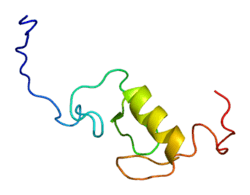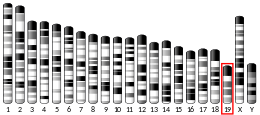PCGF6
Polycomb group RING finger protein 6 is a protein that in humans is encoded by the PCGF6 gene.[5][6]
The protein encoded by this gene contains a RING finger motif, which is most closely related to those of polycomb group (PcG) proteins RNF110/MEL-18 and BMI1. PcG proteins are known to form protein complexes and function as transcription repressors. This protein has been shown to interact with some PcG proteins and act as a transcription repressor. The activity of this protein is found to be regulated by cell cycle dependent phosphorylation. Alternatively spliced transcript variants encoding different isoforms have been identified.[6]
References
- 1 2 3 GRCh38: Ensembl release 89: ENSG00000156374 - Ensembl, May 2017
- 1 2 3 GRCm38: Ensembl release 89: ENSMUSG00000025050 - Ensembl, May 2017
- ↑ "Human PubMed Reference:".
- ↑ "Mouse PubMed Reference:".
- ↑ Akasaka T, Takahashi N, Suzuki M, Koseki H, Bodmer R, Koga H (Aug 2002). "MBLR, a new RING finger protein resembling mammalian Polycomb gene products, is regulated by cell cycle-dependent phosphorylation". Genes Cells. 7 (8): 835–50. PMID 12167161. doi:10.1046/j.1365-2443.2002.00565.x.
- 1 2 "Entrez Gene: PCGF6 polycomb group ring finger 6".
Further reading
- Kanno M, Hasegawa M, Ishida A, et al. (1996). "mel-18, a Polycomb group-related mammalian gene, encodes a transcriptional negative regulator with tumor suppressive activity.". EMBO J. 14 (22): 5672–8. PMC 394682
 . PMID 8521824.
. PMID 8521824. - Trimarchi JM, Fairchild B, Wen J, Lees JA (2001). "The E2F6 transcription factor is a component of the mammalian Bmi1-containing polycomb complex.". Proc. Natl. Acad. Sci. U.S.A. 98 (4): 1519–24. PMC 29289
 . PMID 11171983. doi:10.1073/pnas.041597698.
. PMID 11171983. doi:10.1073/pnas.041597698. - Suzuki M, Mizutani-Koseki Y, Fujimura Y, et al. (2002). "Involvement of the Polycomb-group gene Ring1B in the specification of the anterior-posterior axis in mice.". Development. 129 (18): 4171–83. PMID 12183370.
- Strausberg RL, Feingold EA, Grouse LH, et al. (2003). "Generation and initial analysis of more than 15,000 full-length human and mouse cDNA sequences.". Proc. Natl. Acad. Sci. U.S.A. 99 (26): 16899–903. PMC 139241
 . PMID 12477932. doi:10.1073/pnas.242603899.
. PMID 12477932. doi:10.1073/pnas.242603899. - Ota T, Suzuki Y, Nishikawa T, et al. (2004). "Complete sequencing and characterization of 21,243 full-length human cDNAs.". Nat. Genet. 36 (1): 40–5. PMID 14702039. doi:10.1038/ng1285.
- Deloukas P, Earthrowl ME, Grafham DV, et al. (2004). "The DNA sequence and comparative analysis of human chromosome 10.". Nature. 429 (6990): 375–81. PMID 15164054. doi:10.1038/nature02462.
- Gerhard DS, Wagner L, Feingold EA, et al. (2004). "The status, quality, and expansion of the NIH full-length cDNA project: the Mammalian Gene Collection (MGC).". Genome Res. 14 (10B): 2121–7. PMC 528928
 . PMID 15489334. doi:10.1101/gr.2596504.
. PMID 15489334. doi:10.1101/gr.2596504. - Rual JF, Venkatesan K, Hao T, et al. (2005). "Towards a proteome-scale map of the human protein-protein interaction network.". Nature. 437 (7062): 1173–8. PMID 16189514. doi:10.1038/nature04209.
- Zhong N, Radu G, Ju W, Brown WT (2006). "Novel progerin-interactive partner proteins hnRNP E1, EGF, Mel 18, and UBC9 interact with lamin A/C.". Biochem. Biophys. Res. Commun. 338 (2): 855–61. PMID 16248985. doi:10.1016/j.bbrc.2005.10.020.
- Lee MG, Norman J, Shilatifard A, Shiekhattar R (2007). "Physical and functional association of a trimethyl H3K4 demethylase and Ring6a/MBLR, a polycomb-like protein.". Cell. 128 (5): 877–87. PMID 17320162. doi:10.1016/j.cell.2007.02.004.
This article is issued from
Wikipedia.
The text is licensed under Creative Commons - Attribution - Sharealike.
Additional terms may apply for the media files.





